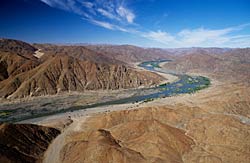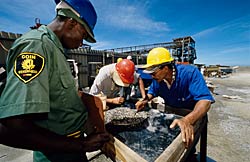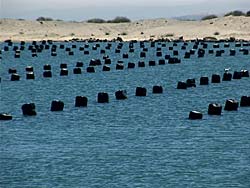Situated in the north-western corner of South Africa the Namakwa District Municipality is made up of six Local Municipalities. The District extends a significant distance inland and is bordered by the Atlantic Ocean in the west and the Orange River in the north. The southern border of the district coincides with the provincial boundary between the Northern Cape and the Western Cape. Three Local Muncipalities border the coast: the Kamiesberg Local Municipality, the Nama Khoi Local Municipality and the Richtersveld Local Municipality.

The Orange River running through the desert landscape
Large mining and fishing companies as well as agriculture dominate these municipalities’ economies. In spite of the wealth generated in these areas the district has the second lowest economic growth rate in South Africa, and unemployment within the region has more than doubled since 1980. This is largely due to the downscaling of the mines. Thus, the need has arisen for alternative forms of livelihoods, which has come mainly in the form of developing eco-tourism. The area is very sparsely settled and the natural environment has International significance because of a unique plant biome called the Succulent-Karoo. Some of the major challenges include declining fish stocks, decommissioning of mining companies (mainly copper and diamonds), poor road infrastructure, lack of sheltered bays for ports, and limited access for communities to coastal resources because mining houses control the land and limited agricultural potential.
The developmental processes in the area fall into six broad categories within which development can be categorised. For further details on the specifics of the processes within each of these broad categories please see below.
Planning Frameworks
Currently the most important process that should in essence guide all development within South Africa is the Integrated Development Planning (IDP) Process. As determined through the principles laid out in the South Africa Constitution and several laws of which the Municipal Systems Act (2000) is particularly important, local government now has a key responsibility in fulfilling civil society's developmental needs. It is thus the priorities of local municipalities that guide development throughout the country. The IDP, by law requires public participation which facilitates the involvement of local communities in developmental and decision making processes. For an example of an Integrated Development Plan please see the Richtersveld Municipality IDP.
Land Reform
For many years economically valuable land within the Namakwa District has been under control of commercial farmers and a few large mining houses. What were previously known as ‘Rural Coloured Reserves' were created on land that was not considered valuable agricultural or mining land. However there are various land reform process under way to transfer land that is of higher agricultural, mariculture and mining value back to the previously disadvantaged communities. This includes the buying up of farms by government for redistribution and the making available of municipal land for farming. The ‘Rural coloured Reserves’ were subject to the Transformation of Certain Rural Areas Act (Law 94 of 1998) that describes a process known as the Transformation Process. Under this process the inhabitants of these communal areas will be able to make a choice of whether they want the title of their land to be transferred to a Community Property Association or to the Local Municipality under whose administrative jurisdiction their land falls. The organisation appointed to facilitate the process in Namakwaland is Surplus Peoples Project (SPP) and they can be reached at: harry@spp.org. In the Richtersveld there are land claims on the land alienated from people by the government-owned Alexkor Ltd diamond mine and on concessions obtained by Trans Hex group under the Apartheid regime. The Richtersveld Sida !Hub Community Property Association (CPA) is represented by Legal resources Centre that can be contacted at: henk@lrc.org. The people of the region have successfully managed to win their land back and the rights are currently in the process of being transferred.
Mining
 Diamond Mining houses control the majority of the Namakwa coastal areas and restricts public access to coastal resources. The mining houses have also been the dominant employer in the region and have thus controlled to a large extent the lives of the people living in this area. However diamonds are not forever and downscaling is taking place. Alternative livelihood options are being sought for communities to break the dependency on mines. Increasing pressure is being placed on the mining houses to fulfill their obligations in terms of developing alternative livelihoods to diamond mining and in stimulating development in the area, and to rehabilitate the land affected by mining activities. The main mining houses are Alexkor Ltd, De Beers Consolidated Mines (Namakwaland Division) and the Trans Hex Group. For more information on non-core mining activities in the Alexkor Ltd area contact Mr Lionel Phillips at: lionelp@alexkor.co.za. Diamond Mining houses control the majority of the Namakwa coastal areas and restricts public access to coastal resources. The mining houses have also been the dominant employer in the region and have thus controlled to a large extent the lives of the people living in this area. However diamonds are not forever and downscaling is taking place. Alternative livelihood options are being sought for communities to break the dependency on mines. Increasing pressure is being placed on the mining houses to fulfill their obligations in terms of developing alternative livelihoods to diamond mining and in stimulating development in the area, and to rehabilitate the land affected by mining activities. The main mining houses are Alexkor Ltd, De Beers Consolidated Mines (Namakwaland Division) and the Trans Hex Group. For more information on non-core mining activities in the Alexkor Ltd area contact Mr Lionel Phillips at: lionelp@alexkor.co.za.
Fishing and mari/agriculture
The main fishing and mariculture companies in the Namakwa District currently operate from the towns of Hondeklipbaai and Port Nolloth. Some of the mining houses that control the rest of the coastal zone have also developed mariculture as well as agriculture industries in line with the development of post-mining alternatives to diamond mining. Alexkor Ltd for instance has an oyster farm that was created by flooding a mining excavation close to the shore. A more recently established privately-run oyster farming project in the De Beers mining area at Kleinzee is making significant progress, and is now delivering high-quality seed oysters to oyster farmers in Saldanha Bay.
Abalone ranching trials conducted over a number of years on this coastline are now showing positive results, although further development in this potentially important branch of mariculture is being hampered by the absence of any official policy or position on the question of abalone ranching.
 The major constraints to the future growth of the industry are the strict controls placed on mariculture operators within the diamond areas and issues around quota systems and emerging community controlled industries. The major constraints to the future growth of the industry are the strict controls placed on mariculture operators within the diamond areas and issues around quota systems and emerging community controlled industries.
Investment in mariculture by the mining industry has to date been minimal, and other operators have not been prepared to invest in these restricted areas under the current constraints imposed by the mining industry’s security concerns. Fishing and mariculture sector scans have been commissioned by the Gariep SDI and the Northern Cape Department of Economic Affairs and a Fishing and Mariculture Development Association (FAMDA) was created to represent stakeholders in the industry. FAMDA is the driving force for the planned Mariculture Park in Port Nolloth, in which it is envisaged that a variety of different species will be cultivated on a commercial basis, with backing from both government and the private sector, along with extensive training and skills development programmes to ensure that significant opportunities are created for the people of the region. The Development Officer, Mr Denver Baron can be contacted at: dbaron@mweb.co.za .
Conservation and Tourism
A growing industry in the district is tourism. As most tourism potential revolves around history, spectacular landscapes and nature and culture-based tourism, the preservation and conservation of these assets are critical.
 The Namakwa district is rather underdeveloped and besides the mining areas is relatively unspoilt and has significant biological wealth in the Succulent-Karoo biome and a seasonal display of wildflowers. The area thus has great potential to attract tourists, and numbers are rising. The industry is mostly controlled from the bigger centres such as Springbok and Cape Town and in the hands of a few influential companies. There are a number of processes under way to involve local communities in this potentially lucrative economy. For more information on tourism and conservation see the “Unfolding the Big Picture” workshop report and visit the South-North Tourism Route website (www.south-north.co.za). The Namakwa district is rather underdeveloped and besides the mining areas is relatively unspoilt and has significant biological wealth in the Succulent-Karoo biome and a seasonal display of wildflowers. The area thus has great potential to attract tourists, and numbers are rising. The industry is mostly controlled from the bigger centres such as Springbok and Cape Town and in the hands of a few influential companies. There are a number of processes under way to involve local communities in this potentially lucrative economy. For more information on tourism and conservation see the “Unfolding the Big Picture” workshop report and visit the South-North Tourism Route website (www.south-north.co.za).
The South-North Tourism Route is a community-based tourism initiative based on equitable, sustainable and responsible tourism in conjunction with local communities from along the route that stretches from Cape Town in the South to !Ganigobes in southern Namibia in the North and consists of grass roots tourism projects at various stages of development.
There are various new opportunities that have arisen within the tourism industry that can lead to increased job creation, such as the Department of Environmental Affairs and Tourism’s Social Responsibility projects. In addition there is a strong case for World Heritage Site Status for certain parts of the region.
|